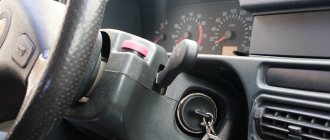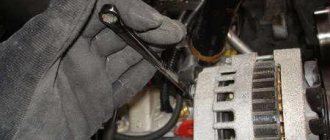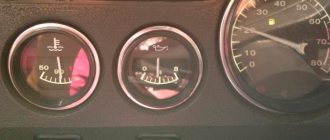One of the most common reasons causing the inability to start a gasoline engine is the banal lack of spark at the spark plugs. Under such circumstances, there is nothing to ignite the combustible mixture on the compression stroke, and as a result, the engine refuses to work. Depending on what kind of power system the car is equipped with, it is determined exactly how to proceed to determine the exact cause of the lack of a spark and measures to return it. We’ll talk in more detail about this problem on injection engines today. Interesting? Then be sure to read the material below to the end.
Checking for spark
Let's say your fuel-injected car has stopped responding to the ignition key and refuses to start. It is quite irrational to immediately complain about a malfunction in the ignition system. First of all, you need to make sure that it is the spark that has disappeared and not something else that has broken. To check spark plugs for the presence of the coveted “light”, you can resort to several procedures at once. Perhaps the most effective and simple ones are the following:
- The first method is a mass test. To implement it, you need to turn off the ignition, unscrew each spark plug in turn and, placing its body against ground (the metal body of the engine), try to start the engine;
- The second method is checking with a multimeter or a tester based on a piezoelectric element. This diagnostic option is quite similar to the method described above, except that the spark plug is applied not to ground, but to the contacts of the tester or multimeter. However, in this case there is no need to “turn” the starter; the spark must come from the devices themselves.
If, as a result of the above-mentioned testing methods, sparking on the spark plug is not detected, or there is a spark, but weak (dimmed, dim, dull), it is necessary to identify the cause of the malfunction. Do not forget that operating a car with a poorly functioning ignition negatively affects engine performance and significantly reduces its service life.
Note! Checking the spark on the injector is an extremely important undertaking, since such cars have very sensitive electronics. Considering this particular feature, it is important to carry out diagnostics carefully and as quickly as possible, that is, without numerous repetitions of the test and using only high-quality testers.
Loss of spark on VAZ 2110, 2112, 2114, 2115 injectors
Loss of spark on VAZ injectors
If the fuel pump is working in your car and the mixture enters the cylinder, but the engine does not start, then most likely the reason is the lack of a spark at the spark plugs. To more accurately diagnose the problem, it is necessary to check the entire electrical circuit for electrical current. The arrester is best suited for these purposes. If there is no spark on the VAZ 2115 injector, and you are trying to check on which cylinder it is missing by placing a wire near ground, this can lead to ignition failure due to increased currents. This can also lead to electrical injuries if there is damage to the insulation. Quite often, if the spark on a VAZ 2114 injector is lost, many resort to checking the spark plugs by applying them to the motor body and powering them from a high-voltage cable. This method is fraught with the occurrence of increased self-induction currents and burnout of the ignition module. The spark gap will not only avoid these problems, but will also become the only possible diagnostic option on cars where two spark plugs are simultaneously supplied with electricity.
Method of using a spark gap for checking spark plugs
If the spark is lost on a VAZ 2112 injector 16 valves, then you can diagnose the breakdown using a spark gap made by yourself. The drawing shows a diagram for checking the presence of a spark simultaneously for 4 conductors,
and the photo shows a device for testing 2 wires.
Having installed the spark plugs in the spark gap, you need to turn on the ignition and observe the occurrence of an electric arc. If it appears on only one of the two spark plugs when the current is distributed simultaneously to 2 spark plugs, this indicates that the conductors or windings of the ignition module have been pierced to ground. If there is no spark on two spark plugs at the same time, the cause should be found in a malfunction of the controller or ignition winding. It is quite possible that this is caused by a broken wire. To determine the integrity of all electrical cables, their resistance is measured - as a rule, it should be identical in all wires of one electrical circuit. The serviceability of the coils is checked using controller diagnostics for errors. If the module cannot be verified, then it is better to simply replace it with a new one (or a used one, but in good working order) and repeat the test again. In the case when there is still no spark on the VAZ 2110 injector 8 valves, you need to diagnose the controller and the electrical wiring connecting it to the coil. If there is no current in all cables, you need to check the power supply to the coil and the presence of a minus. If the wires turn out to be in good condition, then it is necessary to check the functionality of the sensor responsible for the location of the crankshaft. This must be done as follows. Turn off the ignition and the fuel pump stops working. Now, if we start cranking the crankshaft and the pump turns on, then the sensor is in working condition. However, it should be remembered that some models of controllers turn on the pump only when a certain crankshaft speed is reached. If the spark on the VAZ 2110 injector is lost due to a controller malfunction, then in most cases this is caused by a breakdown of the transistor. For this reason, modules also fail. If the module is in compound, the controller must be repaired. To carry it out, basic electrical skills and the ability to use a soldering iron are enough, so you can do it yourself. The sensor breaks very rarely, and if there is no spark in the VAZ 2114 injector, then most likely the contact in the sensor’s power supply is simply broken. This may be caused by dirt, oil, or improper installation of electrical wiring after repairs. If after cleaning all the connecting elements the problem does not disappear, proceed to more specific diagnostics.
https://emex52.ru
legkoe-delo.ru
Causes of sparking problems
If there is no spark on the injector, and not, for example, on a carburetor or gear motor, you will have to try to identify the reasons for its loss. This is due to the fact that there are slightly more factors influencing spark formation in injection systems and they look more multifaceted. If we summarize the general list of possible causes of the problem, then it is worth highlighting the following most common ones:
- The spark plug or spark plugs are flooded with fuel - there is either no spark or very weak, the spark plugs themselves are wet;
- The spark plug or spark plugs are faulty - there is no spark at all, deposits on the contacts are usually black or white;
- The crankshaft sensor, ignition module, ignition coil, switch or distributor is faulty - there is no spark at all, the engine shows no signs of “life”, the injector does not work correctly;
- High-voltage wires have broken through or there has been a loss of contacts - one or two spark plugs do not work, the rest are fully operational;
- The injector electronics (ECU or wires) are faulty - the unit does not work correctly, there is no spark at all spark plugs;
- The injector nozzles are clogged - there is no spark at the spark plugs of specific cylinders, the injector is not working correctly.
Please note that for a complete and most accurate diagnosis, it is necessary to carry out several procedures at once:
- Naturally, check for a spark;
- Assess for the presence of the symptoms described above;
- Check for relevant errors on the dashboard or on-board computer screen;
- Check the potentially faulty unit (disassembly, cleaning, diagnostics with a multimeter, etc.).
If, based on the results of all diagnostic procedures, the problem is not identified, then, most likely, a visit to the service station cannot be avoided. Otherwise, it is quite acceptable to carry out repairs yourself, of course, if you have the proper skills, abilities and tools.
Loss of spark on VAZ 2110, 2112, 2114, 2115 injectors
If the fuel pump is working in your car and the mixture enters the cylinder, but the engine does not start, then most likely the reason is the lack of a spark at the spark plugs. To more accurately diagnose the problem, it is necessary to check the entire electrical circuit for electrical current. The arrester is best suited for these purposes. If there is no spark on the VAZ 2115 injector, and you are trying to check on which cylinder it is missing by placing a wire near ground, this can lead to ignition failure due to increased currents. This can also lead to electrical injuries if there is damage to the insulation. Quite often, if the spark on a VAZ 2114 injector is lost, many resort to checking the spark plugs by applying them to the motor body and powering them from a high-voltage cable. This method is fraught with the occurrence of increased self-induction currents and burnout of the ignition module. The spark gap will not only avoid these problems, but will also become the only possible diagnostic option on cars where two spark plugs are simultaneously supplied with electricity.
Method of using a spark gap for checking spark plugs
If the spark is lost on a VAZ 2112 injector 16 valves, then you can diagnose the breakdown using a spark gap made by yourself. The drawing shows a diagram for checking the presence of a spark simultaneously for 4 conductors,
and the photo shows a device for testing 2 wires.
Having installed the spark plugs in the spark gap, you need to turn on the ignition and observe the occurrence of an electric arc. If it appears on only one of the two spark plugs when the current is distributed simultaneously to 2 spark plugs, this indicates that the conductors or windings of the ignition module have been pierced to ground. If there is no spark on two spark plugs at the same time, the cause should be found in a malfunction of the controller or ignition winding. It is quite possible that this is caused by a broken wire. To determine the integrity of all electrical cables, their resistance is measured - as a rule, it should be identical in all wires of one electrical circuit. The serviceability of the coils is checked using controller diagnostics for errors. If the module cannot be verified, then it is better to simply replace it with a new one (or a used one, but in good working order) and repeat the test again. In the case when there is still no spark on the VAZ 2110 injector 8 valves, you need to diagnose the controller and the electrical wiring connecting it to the coil. If there is no current in all cables, you need to check the power supply to the coil and the presence of a minus. If the wires turn out to be in good condition, then it is necessary to check the functionality of the sensor responsible for the location of the crankshaft. This must be done as follows. Turn off the ignition and the fuel pump stops working. Now, if we start cranking the crankshaft and the pump turns on, then the sensor is in working condition. However, it should be remembered that some models of controllers turn on the pump only when a certain crankshaft speed is reached. If the spark on the VAZ 2110 injector is lost due to a controller malfunction, then in most cases this is caused by a breakdown of the transistor. For this reason, modules also fail. If the module is in compound, the controller must be repaired. To carry it out, basic electrical skills and the ability to use a soldering iron are enough, so you can do it yourself. The sensor breaks very rarely, and if there is no spark in the VAZ 2114 injector, then most likely the contact in the sensor’s power supply is simply broken. This may be caused by dirt, oil, or improper installation of electrical wiring after repairs. If after cleaning all the connecting elements the problem does not disappear, proceed to more specific diagnostics.
emex52.ru
Bringing the car back to life
As for why a spark disappears, everything is probably very clear. Now, it would not be amiss to consider the order of her return. The reality is that in most cases, getting the spark back is a simple matter and just involves carefully checking the broken car. To be more precise, to normalize sparking it is required:
- Firstly, check the spark on the injector using the method described above, make sure that it has disappeared, and, at least indirectly, try to determine the cause of the malfunction;
- Next, it is enough to assess the current circumstances and act based on them. As typical situations, we suggest considering solutions to the following problems:
- the spark plug is wet, the presence and strength of the spark are unimportant, the carbon deposits are correct (brick color) - wipe the part and screw it back in;
- the spark plug is wet (not always) and the carbon deposits are incorrect (white or black) - clean, dry the part and try to start the engine, if there is no result, change the spark plug and deal with problems in the fuel system (cleaning the injector, checking the ECU, etc.);
- the spark plug is wet, there is no spark at all, the color of the soot is not important - we try to change the part, if there is no result, we check the ignition system and the operation of the injector.
In principle, in theory there are no particular difficulties in repairs of this kind. Despite this, it often causes difficulties in implementation for inexperienced motorists. To solve these, you need to act in the order described above, but if something doesn’t work out, it’s better to turn to professionals at a service station. This approach to repairs will not only save time, but also guarantee trouble-free operation of the car in the future.
Perhaps this concludes the most important information on today’s issue. We hope that the material presented was useful to you and provided answers to your questions. Good luck in operating and maintaining your car!
Malfunctions in the ignition system of the VAZ-2115 are always upsetting, because any of them leads to frequent malfunctions of the car’s engine. The main sign by which one can suspect a malfunction in the ignition system is weak caviar or its complete absence.
When you turn the key everything goes out
When you turn the key everything goes out
Signs of a malfunction of the ignition module VAZ 2114
al107 » Mon, 31 Jan 2011, 23:29
Sorry for the possible button accordion. I recently bought a Filicia '98. I haven’t fully figured it out yet and therefore decided to ask you, dear forum users.
Yesterday everything was great, today I took the metro to work and then decided to go by car on business, opened the car with the key (there is no signal, or rather there is, but it was turned off), inserted the key into the ignition, turned it and everything went out. when I got into the car, the light was on, I turned the key in the ignition, the standard lights were on on the instrument panel, and as soon as I turned it to the final position, it started and that’s it, the boat: no lights on the instrument panel, no quiet operation of the stove at first speed, no interior light bulbs. Nothing. I looked at the precautions, everything is normal. I didn’t understand what was going on, I opened the hood to look at the battery, twirled it, reset the terminal, screwed the terminal back and OH MIRACLE, the interior light came on (the door was open). I got into the car, decided to start it again, and again it was a bummer, everything went out.
What could this be? I surfed the forum and saw only a few possible troubles: X-relay, ZhP (some kind of yellow wire), tablet. I still don’t understand what an X-relay, a hard drive and a tablet are.
Please tell me what this could be.
Re: When I turn the key everything goes out
al107 » Tue, 01 Feb 2011, 14:49
In general, I surfed the entire forum. I seem to understand what an x-relay is, a yellow wire from the contact group to the starter and a “talbet”. I don't understand how to check this yellow wire. They say to put it in neutral, on the handbrake and connect the starter directly, how does that work? Sorry for such a frivolous question from a newbie.
When I get home from work, I’ll sort everything out. It’s damn cold, there’s no garage (((
Re: When I turn the key everything goes out
Spyk » Tue, 01 Feb 2011, 16:09
Re: When I turn the key everything goes out
al107 » Tue, 01 Feb 2011, 16:38
Re: When I turn the key everything goes out
Sergey KA » Tue, 01 Feb 2011, 17:01
Re: When I turn the key everything goes out
Olezhek » Tue, 01 Feb 2011, 18:01
The mass runs away, she doesn’t like you. . And all terminals should always be screwed to the battery very tightly.
PS As you go, the battery will soon run out, try to recharge it and look at the date, if it’s 5 years old, then it’s asking for a replacement.
Re: When I turn the key everything goes out
al107 » Tue, 01 Feb 2011, 18:06
Re: When I turn the key everything goes out
Misha1989 » Tue, 01 Feb 2011, 21:34
Re: When I turn the key everything goes out
Sanya_pike » Wed, 02 Feb 2011, 0:39
Re: When I turn the key everything goes out
webster » Wed, 02 Feb 2011, 2:43 am
Re: When I turn the key everything goes out
al107 » Wed, 02 Feb 2011, 10:24
In general, yesterday I climbed under the hood. With a flashlight) I pulled out the battery, cleaned the contacts, inserted it and tightened the terminals on the battery. And voila, my Saraika started up))) I don’t know what it was exactly, either the GB or a bad contact on the battery.
Thank you all for your help and advice.
P.S. Just in case, this weekend I want to change the terminal on the liquid terminal (this one, of course, has already been cleaned, but still).
Re: When I turn the key everything goes out
vladuha » Wed, 02 Feb 2011, 10:39
100% It was the same thing, I removed the battery and then did not tighten the ground terminal.
The problem is complex, I hope I posted it in the right section.
In short: the front driver's window was broken. Since I was not near the car for about a day, presumably the alarm had drained the battery. When you try to start, when you turn the key to the START position, you hear a click, all the indicators go out and nothing else happens. When you turn the key back to the ON position, the indicators light up.
The fault was due to a dead battery, but when lighting a cigarette from another car, it’s the same story.
What could be the problem? (immobilizer, signaling system has switched off and is blocking the starter, spark plugs, starter)
PS: 1) part of the glass fell inside the door, it was raining. Could the electronics be damaged? 2) signaling Sher Khan Magicar B
looks like a short to ground.
check everything. the fuse box in the passenger compartment could be flooded +1
alexchub why didn’t someone like your beauty?
Thanks for the answers =)
The alarm reacts to the key fob, unlocks and locks, and goes into security mode.
>>you should measure the voltage on the battery and what happens to it when you turn the key.
Hm. but when you light a cigarette, the starter actually starts from someone else’s battery. I'll check the voltage on mine when lighting it.
>>As for the rain, the fuse box in the cabin could have flooded
Aren't the fuses for the ignition switch located under the hood? https://chevy-rezzo.narod.ru/ru/documents_2006/nubira-lacetti/ewd-lhd-j/6j2_4.ru.html
The fuse box on the side of the torpedo visually looks normal, everything is dry.
Boss Short to ground, how and where? Where to look :confused:
The neighbor said some drunken guy was hanging around nearby. Who knows, maybe he wanted to steal something, maybe out of envy, maybe just an idiot. I don't know this)
Battery check
A characteristic feature of a problem battery is a change in the sound of the signal. Even if there is a problem with the battery, the lights on the dashboard usually react when the starter rotates. In such a case, the reason why there is no spark may be a low battery charge or broken contact at the terminals.
If the terminals become oxidized, they should be cleaned and securely fastened. You can also apply graphite grease to them; it will prevent the terminals from oxidizing in the future. If the battery is simply discharged, it must be fully charged.
High voltage wires
Next you need to visually check the high voltage wiring. There should be no visible damage or disruption of the insulating layer. If the wiring is in good condition, you should check the wiring to the spark plugs.
To do this, you need to remove the tip from the spark plug wire, bring it to a place on the body without paint and start the car. When the starter rotates, a bright spark with a bluish tint should appear. If this does not happen, you should check the ignition coil.
At the same time, the spark plugs do not fail. If there is a spark in the spark plug wiring, it is possible to check any of the glow plugs. To do this, you need to unscrew the suspicious spark plug from the block and put the spark plug wire on it. Next, you should touch the place on the body without paint with a metal part and, by rotating the starter, determine whether there is a spark or not.
Replacement of spark plugs must occur in a timely manner, in accordance with the maintenance of your car model. For VAZ-2115 - approximately every 20 thousand kilometers.
Distributor
When looking for problems with the distributor, you need to take a close look at the inside of the cap. If there is damage, it should be replaced. If there are no problem areas, wash with gasoline. You can check the central contact of the distributor by moving it slightly to the side.
The integrity of the rotor insulation is easily checked by placing the central high-voltage wire at a distance of 5 mm from the rotor electrode and closing the breaker contacts with the ignition on. Sparks appearing in the gap mean that the rotor is not working and needs to be replaced.
Low voltage circuit
Using a 12V lamp, you can check the low voltage circuit. The lamp must be connected with the first contact to the low voltage terminal, and the second to the car body. Next, you need to close the distributor contacts and start the ignition. If the circuit is OK, the lamp will light when the contacts open and go out when the contacts close.
If the lamp does not light up when the contacts are opened, this means that the problem is in the low voltage wiring or in the ignition coil, or rather, in its winding.
Sources used:
- https://swapmotor.ru/ustrojstvo-dvigatelya/net-iskry-inzhektor.html
- https://ladaautos.ru/vaz-2115/pochemu-net-iskry-na-vaz-2115-inzhektor.html
Low battery
The most common problem in this case! It is especially relevant in winter! In this case, you need to charge, replace the battery, or warm it up (if the problem occurs in winter) or light it.
The main sign of a bad battery will be the noise of the relay operating when you turn the ignition key! But if the battery is “healthy” and the noise of the relay being activated is present, then see the next point.
In general, starting the engine in winter is a separate issue. Which will be the subject of a separate article!











